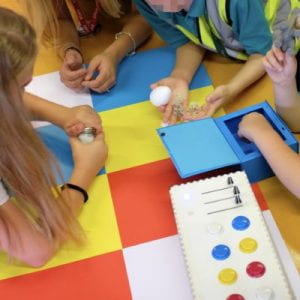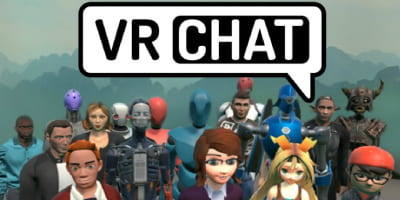What is human-computer interaction?
Human-computer interaction (HCI), is the study of how technology influences the way we make sense of the world. Research here at the University of Bristol is contributing to a greater body of knowledge about how we can make technologies more accessible, and more rewarding than ever before.
Human-Computer Interaction explained
Human-Computer Interaction (HCI) is a dynamic and evolving field of study that traditionally centered on user interface design and optimisation i.e. exploring how we design visual and interactive elements of a software application or website to make them user-friendly.
Bristol’s dedicated HCI research group
 The Bristol Interaction
The Bristol Interaction
Group (BIG) is a dynamic team of researchers
exploring human-technology interactions.
Their diverse projects range from developing digital
tattoos with programmable smart ink to investigating
how virtual reality tools can enhance mental health
and well-being.
In today’s tech-centric world, HCI has expanded its scope to capture the way in which people use their senses to interact with technology. Think about voice commands technologies, and gesture controls like pinch and zoom on a smartphone. These are all mechanisms informed by in-depth HCI research which have translated into the capabilities we find within our everyday devices.
Human-computer interaction at the University of Bristol
HCI research at the University of Bristol is predominantly conducted by the Bristol Interaction Group, a diverse team of computer scientists, psychologist, social scientists, engineers and artists exploring how improvements in technology can have a profound impact on quality of life.
We had the opportunity to connect with Dr Oussama Metatla and Dr Mairi Deighan, both esteemed HCI experts and members of Bristol Interaction Group, to hear about how their research is transforming lives through technology.
Designing accessible technologies for blind and visually impaired children
Technology plays a pivotal role in most, if all, educational settings, but these digitally enhanced learning tools are not always inclusive of their end user.
 Dr Oussama Metatla is a dedicated HCI expert whose research is fuelled by a passion for accessibility-led design and how society can make technologies more inclusive for those with a disability. Through his work, he explores how technology, accessibility, and sensory experiences intersect, providing recommendations for how to design and build assistive technologies that can be easily used and shared by mixed groups. His latest research explores the early cognitive and social development of both blind and sighted children.
Dr Oussama Metatla is a dedicated HCI expert whose research is fuelled by a passion for accessibility-led design and how society can make technologies more inclusive for those with a disability. Through his work, he explores how technology, accessibility, and sensory experiences intersect, providing recommendations for how to design and build assistive technologies that can be easily used and shared by mixed groups. His latest research explores the early cognitive and social development of both blind and sighted children.
In a related series of studies, Dr Metatla explored sensory modalities to understand how smell, taste, and touch can be integrated into technology. He recognises the heightened importance of remaining senses when one is compromised and highlights the critical role of sensory modalities in neurodivergent conditions like autism.
 By combining his research on inclusive technologies and sensory modalities, Dr Metatla co-designed educational tools with impacted users, for example the children interacting with the technology, the parents providing assistance, and teachers who may opt to design and deliver their own low-cost educational tools that provide a fulfilling learning experience for children of varying abilities.
By combining his research on inclusive technologies and sensory modalities, Dr Metatla co-designed educational tools with impacted users, for example the children interacting with the technology, the parents providing assistance, and teachers who may opt to design and deliver their own low-cost educational tools that provide a fulfilling learning experience for children of varying abilities.
Exploring social virtual reality as a mental health tool
 Dr Mairi Deighan, a HCI researcher here at the University of Bristol, conducted a pivotal study on the use of social Virtual Reality (VR) during the COVID-19 pandemic. Motivated by a longstanding interested in VR and a gap in social VR literature, she combined autoethnography – a method where the researcher reflects on personal experiences to understand broader cultural patterns – an online survey, and interviews within VRChat, to explore how users harnessed social VR and how it impacted their mental health and wellbeing.
Dr Mairi Deighan, a HCI researcher here at the University of Bristol, conducted a pivotal study on the use of social Virtual Reality (VR) during the COVID-19 pandemic. Motivated by a longstanding interested in VR and a gap in social VR literature, she combined autoethnography – a method where the researcher reflects on personal experiences to understand broader cultural patterns – an online survey, and interviews within VRChat, to explore how users harnessed social VR and how it impacted their mental health and wellbeing.
Participants of the study reported significant positive impacts from regularly using social VR, including an increased confidence and happiness attributed to the choice of over 4000+ VRChat environments where they could choose to hang out. These environments mimicked real-life social settings like bars, clubs and even space stations. Users also benefited from anonymity on the platform through avatars, allowing participants to express themselves openly, in a judgement-free environment where they afford to take bigger social risks. For example, VRChat allows users to travel away from a situation as they please. This feature instilled confidence in users to initiate a conversation, knowing that they could remove themselves from the situation at any point.
 Dr Deighan’s research findings confirm the role of social VR platforms as transformative spaces, offering a unique opportunity for users to practice social interactions, reduce negative thoughts, and enhance overall mental health. Virtual environments like VRChat empower individuals to form genuine social bonds and are especially valuable to those experiencing social connection for the first time.
Dr Deighan’s research findings confirm the role of social VR platforms as transformative spaces, offering a unique opportunity for users to practice social interactions, reduce negative thoughts, and enhance overall mental health. Virtual environments like VRChat empower individuals to form genuine social bonds and are especially valuable to those experiencing social connection for the first time.


